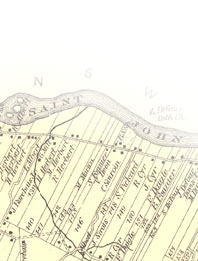|
Several areas of Maine received a large number of French-speaking immigrants
during the 19th and 20th centuries, as Canadians moved from the provinces
of Québec, Nova Scotia, Prince Edward Island, and New Brunswick to the
industrial towns of New England. In Maine these included Biddeford, Lewiston-Auburn,
Saco, and Rumford-Mexico; in the case of the Rumford-Mexico area a large
Acadian population migrated from Prince Edward Island. Today approximately
one-third of the population of Maine (336,127 people) describe themselves
as being of French, French-Canadian, or Acadian ancestry (U.S. Census
1991b).
Starting in the mid-19th century, Maine Acadians migrated from the Valley
to other locales in Maine, Massachusetts, Connecticut, and elsewhere.
In many cases they clustered in what might be termed satellite cultural
communities that maintain contact through family ties and return migration.
Workers and their families first moved from the Upper St. John Valley
in response to a shortage of millworkers in New England resulting from
the Civil War. During the 20th century, mechanization increased the yield
of farmland but reduced the number of laborers required. Facing a decline
in employment opportunities in their home territory, many residents of
the Valley headed south in search of jobs created by industrial growth.
Bristol, Connecticut, for example, was one destination for Valley workers.
A sizable group of Cyrs and Michauds with Valley roots now live in Missoula,
Montana.
On July 5, 1991, Edgar Lavertu of Bristol, who returned to the Valley
for the Lavertu family reunion, shared some of his experiences as an immigrant
from the Valley. He explained that people who migrated to Bristol formed
neighborhood "colonies," often consisting of extended families. The initial
groups were located in urban settings, and he felt the migrant families
maintained their distinct Valley culture to a surprising degree. However,
as individual families gained the means to move to the suburbs, groups
became more dispersed and traditions were harder to maintain.
|
 |
 |
 Migration to and from the Valley (along with other factors) resulted in
a 1990 population on the Maine side totaling approximately 27,000 (U.S.
Census 1991a). The three international ports of entry--Fort Kent (pop.
4,268), Madawaska (pop. 4,803), and Van Buren (pop. 3,045)--are the largest
U.S. towns in the Valley. Frenchville (pop. 1,338) and St. Agatha (pop.919)
form a hub for the Valley's farming. The other villages in the region
are considerably smaller. Some, especially toward the east, such as Grand
Isle, Lille, and Keegan, were larger during the heyday of the St. John
River log drives. The largest settlements in the Upper St. John Valley
border the U.S. study area at Edmundston (pop. 12,044) and Grand Falls/Grand-Sault
(pop. 6,203), New Brunswick.
Migration to and from the Valley (along with other factors) resulted in
a 1990 population on the Maine side totaling approximately 27,000 (U.S.
Census 1991a). The three international ports of entry--Fort Kent (pop.
4,268), Madawaska (pop. 4,803), and Van Buren (pop. 3,045)--are the largest
U.S. towns in the Valley. Frenchville (pop. 1,338) and St. Agatha (pop.919)
form a hub for the Valley's farming. The other villages in the region
are considerably smaller. Some, especially toward the east, such as Grand
Isle, Lille, and Keegan, were larger during the heyday of the St. John
River log drives. The largest settlements in the Upper St. John Valley
border the U.S. study area at Edmundston (pop. 12,044) and Grand Falls/Grand-Sault
(pop. 6,203), New Brunswick.
|
|

